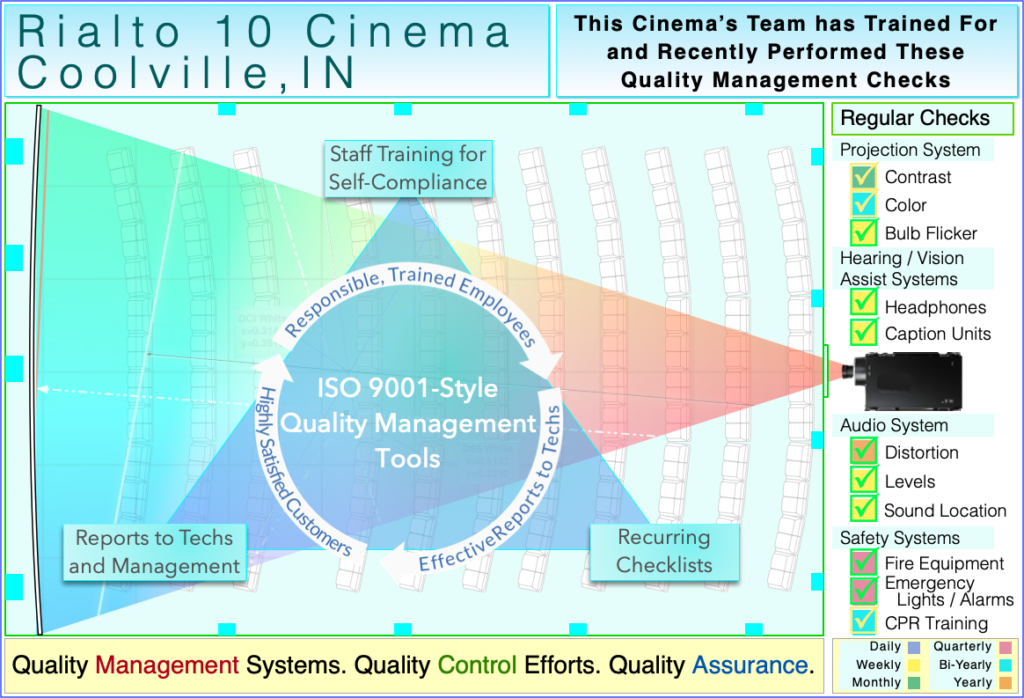What is a Checklist and
…what does it have to do with cinema or
…being QualityActive™ or
…making customers more comfortable and satisfied?
Systems, just like equipment, require control or they turn into expensive doorstops.
Control requires knowledge and some amount of dedication. Perhaps robots can keep everything going…for a while. Even now, computers and robots have a lot of knowledge. But there always seems to be a subtle detail(s) that haven’t yet been programmed into them, and they certainly don’t have a responsibility circuit built in. They don’t have the ability to judge when a little detail might be critically important, so they bump into walls for a few generations.
Good employees always want more responsibility. Checklists help guide people, to take the steps required. …to take the steps consistently.
Here are a couple of examples:
Tuesday Sound – Managers Walk-Through Report Form
Wednesday Picture – Managers Walk-Through Report Form
Something that will always stay amazing is the amount of information needed to keep a facility running well. Constant and consistent attention to small details is mandatory to keep a project from falling into disorganization.
The owner starts a project, like a cinema theater, and has to learn everything the hard way. Even if this new owner has been running a projector for decades, when they have to put in their own projector into their own projection room, suddenly each decision has a hundred more consequences. A wide variety of detail needs to be considered differently; How will employees use this, is it secure against failures and ignorance and malice, is the warranty worthwhile even though the sales person is wonderful? What am I not being told?
The consequences of each decision will cost time and complicate other people’s life if they are not predicted well and handled in advance.
But that isn’t the point of this project. The point is that the owner eventually learns everything and seems like a magician to new employees. How did they know that the clock in the back hall was not correct when they walked in the front door of the facility? Why would anyone care about a clock in the back hall? Or care about some piece of equipment that does not quite sound right?
The reason is that at some point in history something happened that made it important. A meeting was missed by showing up late, a bulb blew up before its time and ruined the optics – something small turned into something big.
But if that owner goes on holiday, they will pick someone who has knowledge of the equipment but not knowledge of the facility, or maybe the opposite. Things will fall apart and nobody will know why. Little things.
If only everything were down on a piece of paper so it could be checked every so often. Everything.
Big companies do this when they sign up to become part of an international Quality Management network called ISO 9001. A) They send a few executives to study the basics for a few months. Then these trained executives B) spend a year or so compiling every small detail of the manufacturing or service that the company provides. Then C) they turn it into a manual that details every process which also includes D) a separate checklist for each 1) item and 2) process that needs to be checked to insure that the customer gets what they were promised.
Two important things: 1) The people who use the equipment and run the processes use these checklists on a regular basis (in addition to the professional technicians who do it every once in a while), and 2) there is a special person in charge of Quality Control who reports directly to the Chair(w0)man of the company.
The Purpose: One thing that we know is that problems can happen during the weeks or months in between professional visits of the calibration teams. We want to catch these problems before the customers do. We want the issues handled efficiently by the technicians who have the training to deal with them.
Oh, and most importantly; to make this work, the users of the checklists are trained to judge their own processes and products.

The users become part of the cycle of responsibility that makes Quality Management turn into Quality Control, and Quality Control turn into Quality Assurance.
Checklists are not used for their own sake. As the illustration shows, they are used as a communication tool for the technicians who typically get sparse reports that cause them to be inefficient.
To go back to the original thought, the checklists aim to fulfill the needs of the replacing the owner so that s/he can get back to the role of innovator and leading the troops toward new challenges and successes. And maybe even taking a vacation without things falling apart!